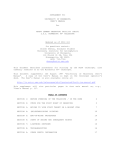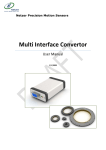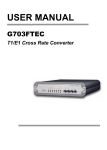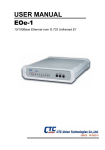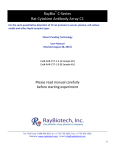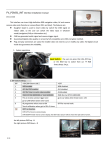Download Instruction Manual PW-DXC-16 Tributary Board - Pacific-Wave
Transcript
User Manual for PW-DXC-16 tributary board Appendix Please read this instruction manual carefully before using the devices. Instruction Manual PW-DXC-16 Tributary Board User Manual for PW-DXC-16 tributary board Contents 1. System Introduction ................................................................................................................................. 3 1.1. Summary: ...................................................................................................................................... 3 1.2. Functions and features .................................................................................................................. 3 1.3. Technology Parameter: ................................................................................................................. 3 2. Front view of DXC-16 tributary board ...................................................................................................... 4 3. Meaning of LED signal light on panel of DXC-16 .................................................................................... 4 4. Structure of DXC-16 Tributary board ....................................................................................................... 5 5. E1 interface line outgoing chart (unbalanced 75Ω) ................................................................................. 5 6. E1 interface outgoing line chart:(balanced 120Ω) ............................................................................... 6 7. Cross-connection function ....................................................................................................................... 7 8. Switchgear setting ................................................................................................................................... 8 9. Clock setting ............................................................................................................................................ 9 10. Solutions and Service Center ................................................................................................................ 9 www.pacificwave-wireless.com Page 2 User Manual for PW-DXC-16 tributary board 1. System Introduction 1.1. Summary: DXC-16 Digit-cross connection equipment is featured with high density, easy operation, perfect management and maintenance function, realizing effective management of transmission network. It provides flexible exchange network and supports 64K signal channel’s non-blocking cross connection of any E1.This equipment possesses processing capacity of channel associated signaling. User can deploy capacity of equipment flexibly, eight E1 or sixteen E1 are available. Synchronous clock can be extracted through circuit or by the equipment. 1.2. Functions and features The minimum resolution of cross-connection is 64Kbit/s; Provides 16 basic group interface which confirms to the suggestion of ITU-T G.703; The impedance is 120Ω or 75Ω; Provides local monitoring interface(RS232, RS485); Provides internal channel, realizing remote operation and control; Arbitrary broadcasting capacity of internal time slots; Cross-connection of channel associated signaling; DC-48V or AC 220V is optional; With processing capacity of digit signal process, signaling process, and so on. 1.3. Technology Parameter: Interface Signaling Rate Level: E1(2048Kbps) Working Temperature: 0℃~40℃ Relative Humidity: less than 85%(+25℃),with no condensation Power Supply: DC-48V or AC220V Power: ﹤20W Ventilation Condition: natural ventilation Cross BAR: 512 bidirectional Signal transmission time skew:﹤600us CAS signal delay:﹤7ms Basic group interface number:16 Interface impedance: 75Ω/120Ω Physical electrical property: confirms to G.730 standard Framing structure: Confirms to G.704 and G.706 standard Precision of internal clock: ±50ppm www.pacificwave‐wireless.com Page 3 User Manual for PW-DXC-16 tributary board 2. Front view of DXC-16 tributary board RUN NET LOF LOS AIS DA MDA MLOF E1/2 E1/1 E1/4 E1/6 E1/4 E1/5 E1/8 E1/7 E1/10 E1/9 E1/12 E1/14 E1/11 E1/13 E1/16 E1/15 3. Meaning of LED signal light on panel of DXC-16 Each tributary board is designed with perfect alarm and indication function. Refer to the following chart for its function and indication meaning. LED title Meaning of signal light Color RUN Power is normal: twinkling Green NET Invalid Green LOF When receiving signal is out of step: lighted Red LOS When inputting signal is lost: lighted Red AIS When receiving signal are all “1”: lighted Yellow DA When remote device alarms: lighted Yellow MDA When opposite device framing alarming: lighted Yellow MLOF When occurs Multi-frame out-of-sync: lighted Red E1/1-E1/16 When channel is occupied: it is lighted and then goes out. Red www.pacificwave‐wireless.com Remarks Detailed alarm indication: ( detailed alarm of a E1 is set through 1 to 6 of SW1 and SW2.For example, if the 3rd seat of SW1 is ON, then the detailed information comes from E1/3 ) Indication when sub-channel is occupied. Page 4 User Manual for PW-DXC-16 tributary board 4. Structure of DXC-16 Tributary board E1/13-E1/16 DB37-CC4/16 converter E1/9-E1/12 (E1/9~E1/16 interface) E1/5-E1/8 DB37-CC4/16 converter SW1 E1/1-E1/4 (E1/1~E1/8 interface) SW2 5. E1 interface line outgoing chart (unbalanced 75Ω) 1)With DB37-CC4-16 converter, ports of E1/9~E1/16 are as the following diagram: th The 16 E1 interface The 12th E1 interface th The 15 E1 interface The 11th E1 interface th The 14 E1 interface The 10th E1 interface th The 13 E1 interface The 9th E1 interface 8 7 6 5 4 3 2 1 Out In 2)With DB37-CC4-16 converter, ports of E1/1~E1/8 are as the following diagram: th The 8 E1 interface The 4th E1 interface th The 7 E1 interface The 3rd E1 interface th The 6 E1 interface The 2en E1 interface th The 5 E1 interface The 1st E1 interface 8 7 6 5 4 3 2 1 Out In www.pacificwave‐wireless.com Page 5 User Manual for PW-DXC-16 tributary board 6. E1 interface outgoing line chart:(balanced 120Ω) E1 interface E1-1 E1-2 E1-3 E1-4 E1-5 E1-6 E1-7 E1-8 Definition DB37 needle number Remarks Receive 3 21 3:RRING 21:RTIP transmit 22 4 22:TRING 4:TTIP Receive 7 25 7:RRING 25:RTIP transmit 26 8 26:TRING 8:TTIP Receive 11 29 11:RRING 29:RTIP transmit 30 12 30:TRING 12:TTIP Receive 15 33 15:RRING 33:RTIP transmit 34 16 34:TRING 16:TTIP Receive 5 23 5:RRING 23:RTIP transmit 24 6 24:TRING 6:TTIP Receive 9 27 9:RRING 27:RTIP transmit 28 10 28:TRING 10:TTIP Receive 13 31 13:RRING 31:RTIP transmit 32 14 32:TRING 14:TTIP Receive 17 35 17:RRING 35:RTIP transmit 36 18 36:TRING 18:TTIP 母头 连接器 DB37-F Connecter www.pacificwave‐wireless.com Page 6 User Manual for PW-DXC-16 tributary board 7. Cross-connection function Any two ports of DXC-16 are available for time slot cross-connection, including point-to-point one way connection and point-to-point two-way connection and point-to-points one way connection. As the following diagram: 1) point-to-point one way connection: 2) point-to-points two-way connection: 3) 4) point-to-points one way connection www.pacificwave‐wireless.com Page 7 User Manual for PW-DXC-16 tributary board 8. Switchgear setting 1)Settings of switchgear(0 is ON,1 is OFF) SW. Default setting ON OFF 1 Display detailed alarm information of E1/1 Not display detailed alarm information of E1/1 Display detailed alarm information of E1/1 OFF 2 Display detailed alarm information of E1/2 Not display detailed alarm information of E1/2 Display detailed alarm information of E1/2 OFF 3 Display detailed alarm information of E1/3 Not display detailed alarm information of E1/3 Display detailed alarm information of E1/3 OFF 4 Display detailed alarm information of E1/4 Not display detailed alarm information of E1/4 Display detailed alarm information of E1/4 OFF 5 Display detailed alarm information of E1/5 Not display detailed alarm information of E1/5 Display detailed alarm information of E1/5 OFF 6 Display detailed alarm information of E1/6 Not display detailed alarm information of E1/6 Display detailed alarm information of E1/6 OFF 7 Display detailed alarm information of E1/7 Not display detailed alarm information of E1/7 Display detailed alarm information of E1/7 OFF 8 Display detailed alarm information of E1/8 Not display detailed alarm information of E1/8 Display detailed alarm information of E1/8 OFF 9 Display detailed alarm information of E1/9 Not display detailed alarm information of E1/9 Display detailed alarm information of E1/9 OFF 10 Display detailed alarm information of E1/10 Not display detailed alarm information of E1/10 Display detailed alarm information of E1/10 OFF 1 Display detailed alarm information of E1/11 Not display detailed alarm information of E1/11 Display detailed alarm information of E1/11 OFF 2 Display detailed alarm information of E1/12 Not display detailed alarm information of E1/12 Display detailed alarm information of E1/12 OFF 3 Display detailed alarm information of E1/13 Not display detailed alarm information of E1/13 Display detailed alarm information of E1/13 OFF 4 Display detailed alarm information of E1/14 Not display detailed alarm information of E1/14 Display detailed alarm information of E1/14 OFF 5 Display detailed alarm information of E1/15 Not display detailed alarm information of E1/15 Display detailed alarm information of E1/15 OFF 6 Display detailed alarm information of E1/16 Not display detailed alarm information of E1/16 Display detailed alarm information of E1/16 OFF 7 System uses internal clock of equipment System clock is selected by software OFF 8 Framing mode of device is PCM31 Framing mode is selected by software OFF SW1 SW2 Priority rating Number 9 Invalid OFF 10 Invalid OFF www.pacificwave‐wireless.com Page 8 User Manual for PW-DXC-16 tributary board Any detailed alarm information of E1/1~E1/16 can be displayed through switchgear SW1 AND SW2. Each time display one E1 alarm information; If there are many E1 require to display, E1 with higher level prevails. 9. Clock setting The equipment is furnished with internal clock or link clock. When choosing internal clock, the precision is ±50PPM. When choosing link clock, DXC-16 can be synchronous with any E1 clock of E1 interface from 1 to 16. 1) Set the 7th seat of SW2 to ON, the system uses the internal clock provided by equipment; 2) Set the 7th seat of SW2 to OFF, the system clock is determined by software, any E1 clock of E1 interface from 1 to 16. www.pacificwave‐wireless.com Page 9










